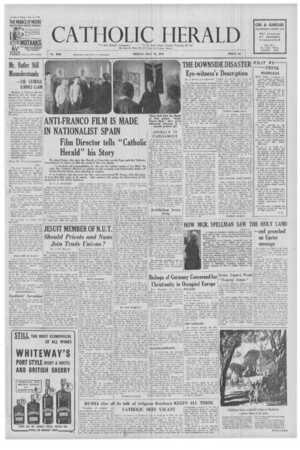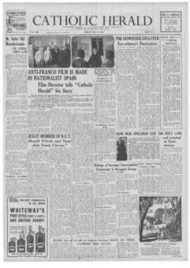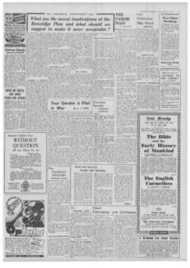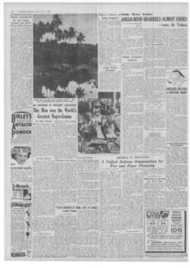Page 1, 21st May 1943
Page 1

Report an error
Noticed an error on this page?If you've noticed an error in this article please click here to report it.
Tags
Share
Related articles
Downside Wartime Tragedy Remembered
Benedictines Bowled Over By Downside Celebrity Batsmen
Downside Boys Kicked Out Of Touch
Anyone For Cricket?
Downside Headmaster In Car Crash
THE DOWNSIDE DISASTER Eye-witness's Description
By a Special Correspondent
The Downside disaster occurred on Saturday afternoon at about 120 during a school cricket match against an army team, when a Hurricane crashed among the boys who were spectators. Eight boys and the pilot were killed almost instantly, and another boy jied 54 hours later.
The tragedy happened after an hour's play. The school was batting. It had been a monotonously slow game, only fourteen runs being 'scored for three wickets. The result was that when two aircraft flew over and began circling the spacious cricket ground, the interest' of the boys moved from the slow cricket to the Hurricanes. Even the players had an occasional pause to watch the planes, which were now" diving over the field and banking steeply.
The noise of their engines was heard for about ten minutes before they made a large circle, preparing to come in even lower over the ground. The first Hurricane flew over the skirting treetops with a roar and across the. wicket, not much higher than the pavilion. Attention was fixed on it while the boys waited for the second to follow. It skimmed the same trees a moment later, but the pilot had. misjudged his
Mr, R. R. Stokes asked the First Lord of the Admiralty in the House of Commons whether he had any statement to ntake on the Downside disaster and whether the strictest instructions will be given forbidding low flying aver playing fields and buildings in future?
Ihe First Lord of the Admiralty, Mr. A. V. Alexander, replied that an official inquiry is being held into this tragic occurrence, and until this has completed its work it would he premature to make any detailed statement. " 1 can, however, say,he added, " that standing Admiralty orders prohibit flying below 2,000 feel except in a few specially selected training areas."
Mr. Stokes said, " While not wishing to prejudice the issue In view of the inquiry, way I ask whether my right hon. Friend is not aware that this was not lust an incident and that these planes vvere flying low over the field for a considerable time. only a few feet above the ground, so that the game had to stop?"
height ; he was too low. It hit the earth about forty yards behind double bank overlooking the playing field, ploughed through the ground, bounced and toppled over the hank.
The boys, who ale accustomed to sit on these banks during school matches, had little or no warning of the threatening disaster, The now burning wreck came to rest among them after thee or four seconds of crashing. A few of the boys were pinned under the blazing aircraft, while otheis welt. crushed by pieces of flying metal. Homing petrol added to the chaos.
FIFTEEN YARDS AWAY From my position, approximately fifteen yards from the burning plane, I had an unhindered view. of the tragedy, As the burning Hurricane at last ended up I could see a score of boys scrambling in all directions to avoid the enveloping flames. The victims had little chance of rising to their feet before they were pinned down beneath the fuselage and the flaming wings.
The suddenness of the calamity held a few of the youngest spellbound, and a prefect, R. M. Butcher, made a gallant effort to save the life of one small boy in such a condition. As the plane raced down upon them he attempted to pull him aside, but the boy remained immovable, Another, D. H. Lowndes, was killed instantly by the flying supercharger as he was sitting in a deck-chair.
The rescue work was carried out by the boys who had escaped and the members of the army team, who made improvised stretchers nut of benches and gymnasium mats. Army trucks carried the wounded and dying death to the school, a distance of some three hundred yards, one boy dying on the journey down.
NEW ZEALAND PILOT KILLED
While casualties were being taken away, Dom Brendan 1 aver' and Dom Ralph Russell anointed the more seriously injured, while Dom Dunstan Pontifex gave absolution. Dom WulStan Phillipson, the housemaster of nearly all the boys concerned, did heroic rescue work, and although collapsing at one stage carried on.
As the rescue work proceeded ammunition was exploding the whole time. The pilot. a New Zealander, was killed immediately on crashing, but it was found that his parachute had partly opened. He was dressed in grey flannel trousers and a white sports shirt.
blog comments powered by Disqus







